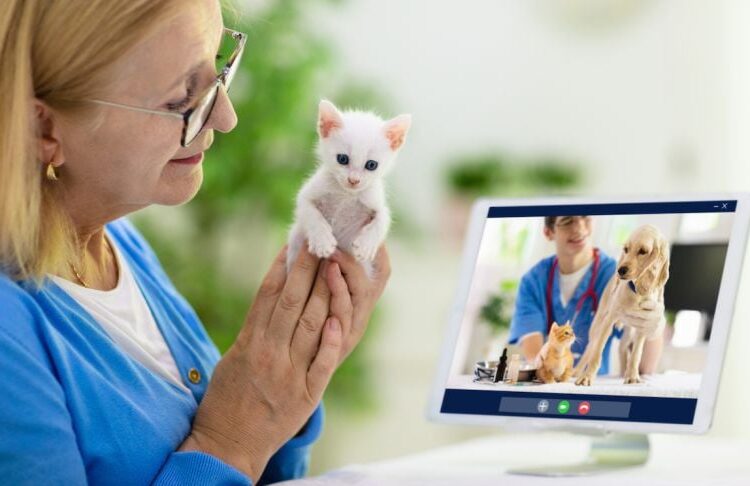The landscape of veterinary care is undergoing a seismic shift, propelled by technological advancements and changing consumer expectations. What was once exclusively a hands-on, in-clinic experience is now increasingly complemented by virtual vet services, often referred to as veterinary telemedicine. This explosion in remote care options is fundamentally reshaping how pet owners access professional advice, manage their pets’ health, and respond to common concerns, offering unparalleled convenience, accessibility, and efficiency.Driven by innovation and accelerated by recent global events, veterinary telemedicine is no longer a niche offering but a mainstream solution. From quick consultations for minor ailments to remote monitoring of chronic conditions and behavioral advice, virtual vet platforms are empowering pet owners while optimizing veterinary practices. This comprehensive article delves into the burgeoning world of virtual vet services, exploring its rapid growth, the diverse range of offerings, its significant benefits, the current limitations and regulations, and what the future holds for this transformative aspect of pet care.
The Rapid Ascent of Veterinary Telemedicine

While the concept of remote medical consultation isn’t new, its widespread adoption in the veterinary field is a relatively recent phenomenon. Several key factors have fueled this remarkable surge:
A. Technological Advancements: The proliferation of high-speed internet, reliable video conferencing tools, and user-friendly mobile applications has made seamless virtual communication a reality.
B. Increased Pet Ownership: A growing global pet population means more demand for veterinary services, pushing for more efficient delivery models.
C. Pet Humanization: As pets are increasingly viewed as family members, owners seek convenient and high-quality healthcare options that integrate into their busy lives.
D. Geographic Barriers: For pet owners in rural areas or those with mobility challenges, virtual services bridge the gap to veterinary expertise.
E. Urgency for Convenience: Modern lifestyles prioritize immediate access and convenience. Virtual vets offer quick consultations without the need for travel or waiting rooms.
F. Enhanced Data Collection: Smart pet tech (wearables, smart feeders) provides data that can be shared remotely with vets, enabling more informed virtual assessments.
The COVID-19 pandemic acted as a major catalyst, forcing a rapid shift towards remote solutions across many industries, including veterinary medicine. This period demonstrated the viability and effectiveness of virtual consultations, leading to a permanent change in how many practices operate and how pet owners seek care.
Diverse Offerings of Virtual Vet Services
Veterinary telemedicine encompasses a broad spectrum of services, ranging from basic advice to more complex remote monitoring. It’s crucial to understand that not all virtual services offer the same level of care; the scope often depends on local regulations and the veterinarian-client-patient relationship (VCPR).
A. Teleconsultation (Live Video/Audio Calls)
This is the most common form of virtual vet service, allowing real-time interaction.
- Non-Emergency Triage: Owners can quickly determine if a physical vet visit is necessary for symptoms like mild vomiting, diarrhea, limping, or skin irritations.
- Follow-up Appointments: Ideal for checking on a pet’s recovery after surgery, monitoring chronic conditions (e.g., diabetes, allergies, arthritis), or adjusting medication dosages.
- Behavioral Consultations: Vets or veterinary behaviorists can observe a pet’s behavior in its natural environment and provide advice for anxiety, aggression, or training issues.
- Nutritional Counseling: Vets or veterinary nutritionists can offer dietary advice, weight management plans, or recommendations for prescription diets.
- Post-Operative Care Instructions: Guiding owners through wound care, medication administration, or activity restrictions after a procedure.
- General Wellness Advice: Discussions about preventative care, vaccinations, parasite control, or age-related changes.
- Prescription Refills (with VCPR): In many jurisdictions, a valid VCPR (established through an in-person exam) is required for medication prescriptions.
B. Teletriage (Information Gathering for Urgency Assessment)
Often the first point of contact, teletriage involves collecting information to assess the urgency of a pet’s condition.
- Symptom Checkers/Chatbots: AI-powered tools or simple questionnaires that guide owners through a series of questions to help them understand potential conditions and decide if a vet visit is needed immediately.
- Nurse/Technician Consults: Registered veterinary nurses or technicians providing initial advice on non-life-threatening issues, guiding owners on whether to schedule an in-person visit, monitor at home, or seek emergency care.
C. Telemonitoring (Remote Health Tracking)
Leveraging smart pet technology to continuously monitor a pet’s health data.
- Wearable Devices: Smart collars or vests that track activity levels, sleep patterns, heart rate, respiration, and temperature. Data can be transmitted to the vet for review.
- Smart Feeders/Water Bowls: Monitoring food and water intake, which can indicate changes in appetite or thirst.
- Post-Surgical Monitoring: Remote tracking of a pet’s vital signs or activity levels during recovery.
- Chronic Disease Management: For conditions like diabetes, owners can log glucose readings or insulin dosages for remote review by the vet.
D. Teleconsultation with Specialists
General practice veterinarians can consult with specialists (e.g., cardiologists, oncologists, radiologists) remotely to discuss complex cases, review diagnostic images, or get a second opinion. This expands the reach of specialized expertise.
E. Online Education and Resources
Many virtual vet platforms also offer a wealth of educational articles, videos, and personalized advice specific to a pet’s breed or condition, empowering owners with knowledge.
The Myriad Benefits of Virtual Vet Services

The adoption of veterinary telemedicine brings significant advantages for pet owners, their animals, and the veterinary community.
A. Unparalleled Convenience
- No Travel Time: Eliminates the need for commuting to a vet clinic, saving time and fuel.
- Flexible Scheduling: Often easier to book quick virtual appointments that fit into busy schedules, including after-hours.
- Reduced Waiting Room Stress: Pets can be examined in the comfort and familiarity of their own home, reducing anxiety associated with clinic visits. This is particularly beneficial for nervous, anxious, or reactive pets.
B. Enhanced Accessibility
- Geographic Reach: Provides access to veterinary care for owners in remote areas or those without readily available local vets.
- Mobility Impaired Owners/Pets: Easier for owners with limited mobility or pets with severe pain/mobility issues to receive care.
- Broader Specialist Access: Allows general vets to consult with specialists more readily, improving case management even if the specialist is not local.
C. Cost-Effectiveness
- Lower Consultation Fees: Virtual consultations are often less expensive than in-person office visits for non-emergency issues.
- Avoidance of Unnecessary Visits: Teletriage can help owners determine if an in-person visit is truly needed, preventing costly and time-consuming unnecessary trips.
- Early Intervention: Addressing minor issues virtually can prevent them from escalating into more serious (and expensive) conditions.
D. Continuity of Care
- Follow-up Efficiency: Makes it easier for vets to conduct follow-up checks, ensuring pets remain on track with treatment plans.
- Chronic Condition Management: Facilitates regular check-ins for pets with chronic diseases, allowing for timely adjustments to medication or diet.
E. Improved Pet Welfare
- Reduced Stress: Less travel and fewer stressful clinic visits contribute to better mental well-being for anxious pets.
- Quicker Advice: Owners can get professional advice faster for concerns that aren’t emergencies, leading to prompt action and potentially better outcomes.
- Behavioral Observation: Observing pets in their natural home environment during virtual consults can provide more accurate insights into behavioral issues.
F. Empowering Pet Owners
Virtual services provide owners with more direct access to information and professional guidance, enabling them to be more proactive and informed participants in their pet’s health journey.
Limitations and Regulatory Challenges
Despite its immense potential, veterinary telemedicine faces several limitations and regulatory hurdles that currently restrict its full capabilities.
A. The Veterinarian-Client-Patient Relationship (VCPR)
This is the most significant regulatory barrier. A valid VCPR is typically required before a veterinarian can diagnose, prescribe medication, or establish treatment plans.
- In-Person Exam Requirement: In most jurisdictions (including many states in the U.S. and countries in Europe/Asia), a VCPR can only be established after a physical, in-person examination of the animal by the veterinarian.
- Impact on Virtual Care: This means that a virtual vet service usually cannot legally diagnose new conditions or prescribe new medications without a prior in-person visit. Virtual vets are often limited to offering general advice, triaging, or follow-up care for conditions already diagnosed by the pet’s regular vet with an established VCPR.
B. Inability to Perform Physical Exams
A virtual platform cannot replace the tactile, olfactory, and auditory information gathered during a physical exam. Vets cannot:
- Palpate Organs: To check for lumps, tenderness, or abnormalities.
- Auscultate Heart/Lungs: To listen for murmurs, arrhythmias, or abnormal breathing sounds.
- Perform Diagnostic Tests: Blood draws, X-rays, ultrasounds require in-person presence.
- Assess Pain Accurately: While behavioral cues can be observed, precise pain localization is difficult.
C. Technology Barriers
- Internet Connectivity: Reliable high-speed internet is essential for video calls.
- Digital Literacy: Some pet owners may not be comfortable with technology.
- Equipment Access: Not all owners have smartphones or computers with cameras and microphones.
D. Emergency Situations
Telemedicine is generally not suitable for true emergencies (e.g., severe trauma, profuse bleeding, collapse, difficulty breathing). These require immediate in-person veterinary intervention.
E. Data Security and Privacy
Ensuring the secure transmission and storage of sensitive pet and owner data is crucial to maintain trust and comply with privacy regulations.
F. Payment and Insurance Integration
Seamless integration with pet insurance claims and various payment methods is still evolving.
The Future Trajectory of Virtual Vet Services
The field of veterinary telemedicine is dynamic and poised for significant growth and innovation, addressing current limitations.
A. Evolving Regulations
Many regulatory bodies are actively reviewing and updating VCPR requirements to better accommodate telemedicine, potentially allowing for VCPR establishment via virtual means in certain limited circumstances, especially for established pet owners within a specific practice.
B. Advanced Remote Diagnostics
Integration of smart devices that allow owners to collect and transmit more sophisticated data:
- Remote Stethoscopes: Devices that can transmit heart and lung sounds to a vet.
- Dermatoscopes: Attachments for smartphones to capture high-resolution images of skin lesions for remote evaluation.
- Wearable Biosensors: More advanced wearables that can monitor a wider range of physiological parameters and even detect early signs of illness through AI analysis.
C. AI and Machine Learning Integration
- Enhanced Triage: AI-powered chatbots and symptom checkers will become more sophisticated, offering more accurate initial assessments.
- Predictive Analytics: AI analyzing data from smart devices to predict potential health issues before symptoms become apparent.
- Personalized Recommendations: AI assisting vets in tailoring advice based on a pet’s unique data profile.
D. Specialized Telemedicine Platforms
Growth of platforms dedicated to specific veterinary specialties (e.g., teledermatology, tele-oncology, tele-behavioral medicine), allowing direct access to specialists.
E. Hybrid Care Models
The most likely future is a seamless blend of in-person and virtual care. Vets will use telemedicine for routine follow-ups, initial triage, and chronic condition management, freeing up in-clinic time for critical care, surgeries, and diagnostics.
F. Increased Education and Training
Veterinary schools and continuing education programs will increasingly incorporate telemedicine training for future and current veterinarians.
G. Tele-Rehabilitation
Remote guidance for physical therapy exercises and rehabilitation protocols for pets recovering from injury or surgery.
Maximizing Your Virtual Vet Experience
For pet owners, making the most of virtual vet services involves preparation and understanding.
A. Have a Valid VCPR
If you need a diagnosis or prescription, ensure you have an established VCPR with your regular veterinarian or a vet offering virtual services who operates under regulations allowing VCPR establishment remotely (if applicable in your area).
B. Prepare Ahead of Time
- List Symptoms: Write down your pet’s symptoms, when they started, their severity, and any changes.
- Gather Records: Have your pet’s medical history, vaccination records, and current medications handy.
- Take Photos/Videos: Capture photos or short videos of symptoms (e.g., limping, skin rashes, abnormal breathing) to share with the vet.
- Check Lighting/Sound: Ensure you’re in a well-lit, quiet area with good internet connection.
- Have Your Pet Ready: Have your pet nearby and try to keep them calm.
C. Be Clear and Detailed
Describe your pet’s condition as thoroughly as possible. Answer the vet’s questions honestly and completely.
D. Ask Questions
Don’t hesitate to ask for clarification on any advice or instructions. Understand next steps, potential costs, and when to seek in-person care.
E. Follow Instructions
Just as with an in-person visit, diligently follow the veterinarian’s recommendations regarding monitoring, medication, or follow-up actions.
Conclusion
The “Virtual Vet Services Explode” trend is a testament to the power of technology to revolutionize traditional industries, particularly in the compassionate field of pet care. By offering unprecedented convenience, accessibility, and efficiency, veterinary telemedicine is empowering pet owners and enhancing the well-being of animals worldwide. While current regulatory frameworks and the inherent limitations of remote physical exams present ongoing challenges, the future of this sector is bright.
As technology continues to advance and regulations adapt, virtual vet services will become an even more integral and seamless part of a comprehensive pet health strategy. It’s a transformative shift that promises to bring high-quality, accessible veterinary care closer to every pet owner, ensuring our beloved companions receive the attention they need, precisely when they need it, from the comfort of their own homes. The revolution in pet healthcare is truly underway, one virtual consultation at a time.












